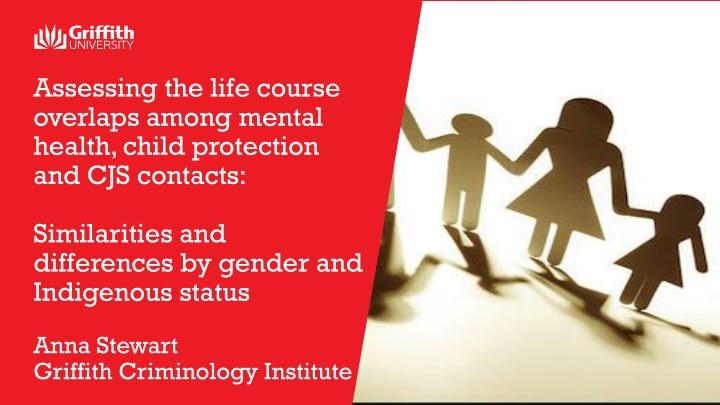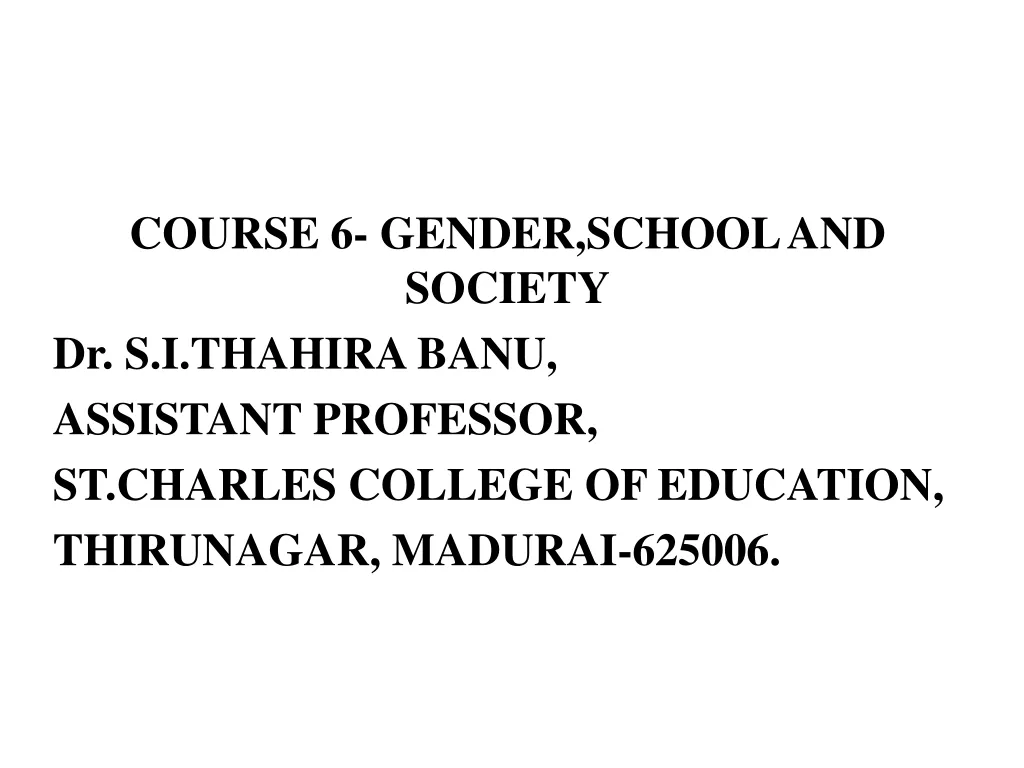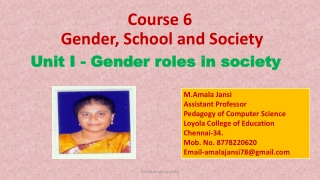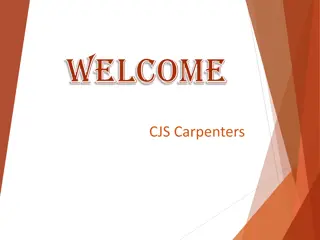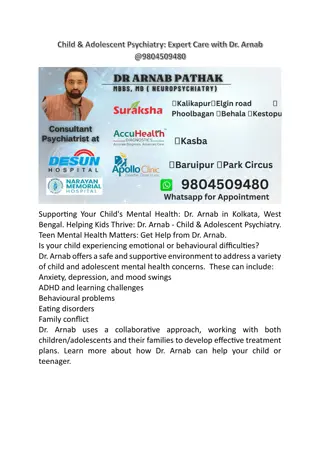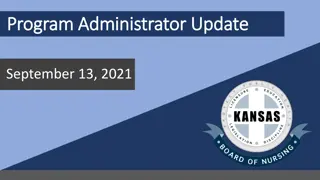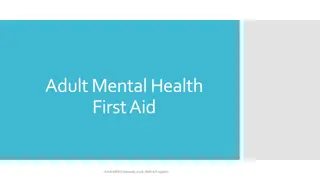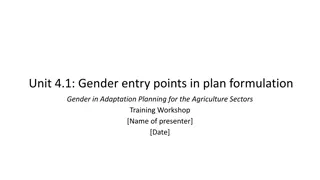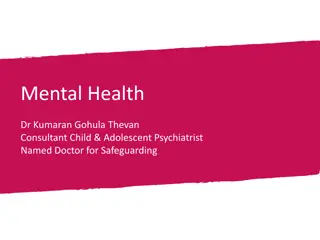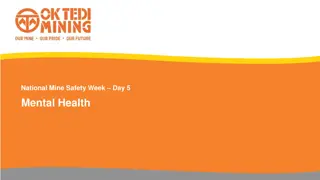Life Course Overlaps in Mental Health, Child Protection, and CJS Contacts: Gender and Indigenous Status
Analyzing life course intersections between mental health, child protection, and the criminal justice system by gender and Indigenous status. The study delves into similarities and differences to understand these complex relationships.
Download Presentation

Please find below an Image/Link to download the presentation.
The content on the website is provided AS IS for your information and personal use only. It may not be sold, licensed, or shared on other websites without obtaining consent from the author.If you encounter any issues during the download, it is possible that the publisher has removed the file from their server.
You are allowed to download the files provided on this website for personal or commercial use, subject to the condition that they are used lawfully. All files are the property of their respective owners.
The content on the website is provided AS IS for your information and personal use only. It may not be sold, licensed, or shared on other websites without obtaining consent from the author.
E N D
Presentation Transcript
Assessing the life course overlaps among mental health, child protection and CJS contacts: Similarities and differences by gender and Indigenous status Anna Stewart Griffith Criminology Institute
Queensland Linkage Project (QLP) Longitudinal population data 31 years old (1983), 30 years old (1984) and 25 years old (1990) Individual level linked data for everyone who had contact with; Queensland Births, Deaths and Marriages register Child protection system (victim and maltreater) Queensland Police Service (youth cautioning and conferencing) Courts (youth and adult court appearances) Corrections (community and custodial) Domestic Violence Protection Orders (civil orders - respondent and aggrieved) Queensland Health (hospital admissions, mental health contacts, emergency dept) 269,784 unique individuals (more than 2.5 million contacts) Data stored in the Social Analytics Lab (SAL) at Griffith University
ARC Funded project: Understanding the relationship between mental illness and offending: Implications for crime prevention and the management of mentally ill offenders Chief Investigators Me Susan Dennison Troy Allard Steve Kisely (UQ) Project Manager Carleen Thompson Partner Organisations Queensland Government Statisticians Office (QGSO) Queensland Health Queensland Police Service Youth Justice Child Safety Disclaimer: The opinions expressed in this presentation are those of the presenter and do not reflect the official policy or position of the Queensland government
Why do data linkage? Siloing of systems, understanding the overlap between welfare, justice and health Understanding individual development across the life course Understanding how individuals accrue cumulative disadvantage across systems Identifying prevention and intervention points, preferably early in the pathways Recognising challenges to professionals working in the silos
Why the focus on mental heath? Since the 1960 s - policy of deinstitutionalisation of the mentally ill Reduction in psychiatric institutional beds 281 per 100,000 early 60s 40 per 100,000 early 1990 s Rationale for treatment in the community Reduce stigma Increase visibility in the community Focus on mental health not mental illness New pharmacological treatment options However, policy implementation lacked resources, quality trained staff, adequate community mental health services and hospital services
Why focus on the overlap? Result Increases in poverty and family stress Increases in homelessness Criminalisation of the mentally ill? Increased visibility of minor criminal offences Criminal sanctions for behaviours related to their mental illness Prisons dumping grounds for mentally ill?
Research Questions Is there an overlap among child maltreatment, mental illness and offending? Examine by gender and Indigenous status What comes first, child maltreatment or offending? What comes first, mental illness or offending? Griffith Criminology Insittute
Research Questions Is there an overlap among child maltreatment, mental illness and offending? Examine by gender and Indigenous status What comes first, child maltreatment or offending? What comes first, mental illness or offending? Health Warning: This presentation contains lots of numbers Griffith Criminology Insittute
1990 Longitudinal population data 45,432 individuals born in Queensland in 1990 25 years old at time of data linkage 269 deaths ( 34% female, 66% male) (excluded) Offenders (10 25 years) at least one finalised guilty court appearance (children s and adult) Mentally ill (5 25 years) at least one mental health hospital admissions (QHAPDC) Maltreated children (0 18 years) at least one substantiated child maltreatment Not include data from Mental Health courts
Mental Health Courts Decides if people unsound mind when they committed an offence fit for trail In 2016/2017 made findings relating to 298 cases 90 found fit for trial Griffith Criminology Insittute
Summary statistics: Mental Health In 1990 45,163 individuals were born in Queensland 6.4 % of population admitted, at least once, to hospital for mental health (age 5 to 25 years) 20 % of all female Indigenous Queenslanders 20 % of all male Indigenous Queenslanders 6% of all female non-Indigenous Queenslanders 6 % of all male non-Indigenous Queenslanders
Summary statistics: Mental Health In 1990 45,163 individuals were born in Queensland 6.4 % of population admitted, at least once, to hospital for mental health (age 5 to 25 years) 20 % of all female Indigenous Queenslanders 20 % of all male Indigenous Queenslanders 6% of all female non-Indigenous Queenslanders 6 % of all male non-Indigenous Queenslanders
Summary statistics: Child maltreatment In 1990, 45,163 individuals were born in Queensland 5.8% investigated and substantiated, at least once, for maltreatment (by age 18) 35 % of all female Indigenous Queenslanders 26 % of all male Indigenous Queenslanders 5 % of all female non-Indigenous Queenslanders 4 % of all male non-Indigenous Queenslanders Indigenous children significantly more substantiations than non-Indigenous children
Summary statistics: Child maltreatment In 1990, 45,163 individuals were born in Queensland 5.8% investigated and substantiated, at least once, for maltreatment (by age 18) 35 % of all female Indigenous Queenslanders 26 % of all male Indigenous Queenslanders 5 % of all female non-Indigenous Queenslanders 4 % of all male non-Indigenous Queenslanders Indigenous children significantly more substantiations than non-Indigenous children
Summary statistics: Youth Offending In 1990, 45,163 individuals were born in Queensland 3.2% of population found guilty, at least once, of an offence in the Children s court (age 10 17 years) 22 % female Indigenous Queenslanders 41 % male Indigenous Queenslanders 1 % female non-Indigenous Queenslander 3.4 % male non-Indigenous Queenslanders Indigenous children significantly more appearances than non-Indigenous children
Summary statistics: Youth Offending In 1990, 45,163 individuals were born in Queensland 3.2% of population found guilty, at least once, of an offence in the Children s court (age 10 17 years) 22 % female Indigenous Queenslanders 41 % male Indigenous Queenslanders 1 % female non-Indigenous Queenslander 3.4 % male non-Indigenous Queenslanders Indigenous children significantly more appearances than non-Indigenous children
Summary Statistics: Adult offending In 1990, 45,163 individuals were born in Queensland 24.7% of the population were found guilty of at least one offence in the adult court before 25 years 63% female Indigenous Queenslanders 84 % male Indigenous Queenslanders 12 % female non-Indigenous Queenslanders 33 % male non-Indigenous Queenslanders Only 19 (1.3%) of youth offenders did not also appear in the adult court
Summary Statistics: Adult offending In 1990, 45,163 individuals were born in Queensland 24.7% of the population were found guilty of at least one offence in the adult court before 25 years 63% female Indigenous Queenslanders 84 % male Indigenous Queenslanders 12 % female non-Indigenous Queenslanders 33 % male non-Indigenous Queenslanders Only 19 (1.3%) of youth offenders did not also appear in the adult court
Summary Statistics: Ever imprisoned In 1990, 45,163 individuals were born in Queensland 1.7% (n = 751) were sentenced to prison (youth detention or adult prison) at least once before 25 years 7.6% female Indigenous Queenslanders 29.4% male Indigenous Queenslanders 0.2% female non-Indigenous Queenslanders 1.9% male non-Indigenous Queenslanders 75% of young people sentenced to youth detention were also later sentenced to adult prison
Summary Statistics: Ever imprisoned In 1990, 45,163 individuals were born in Queensland 1.7% (n = 751) were sentenced to prison (youth detention or adult prison) at least once before 25 years 7.6% female Indigenous Queenslanders 29.4% male Indigenous Queenslanders 0.2% female non-Indigenous Queenslanders 1.9% male non-Indigenous Queenslanders 75% of young people sentenced to youth detention were also later sentenced to adult prison
Question 1: What are the overlaps among child protection, mental health and criminal court systems?
Finalised court appearance (25%) Substantiated Child Protection (5.8%) MH Hospital Admission (6.4%) Total population = 45,163
70% individuals had no contact Finalised court appearance (25%) Substantiated Child Protection (5.8%) MH Hospital Admission (6.4%) Total population = 45,163
5.8% individuals with child protection substantiations Finalised court appearance 38% 14% Substantiated Child Protection only (41%) MH Hospital Admission 7% Individuals = 2,607
6.4% individuals with hospital admissions for mental health Finalised court appearance 39% 13% Substantiated Child Protection only MH Hospital Admission (41%) 6% Individuals = 2,873
10%3% court only 9% court and child protection court and mental health court, child protection and mental health 78% 1990 birth cohort with a finalised court appearance by 25 years (25%; N = 11,185)
100 80 60 40 20 0 Indigenous Females Indigenous Males Non-Indigenous Females Non-Indigenous Males Court only Court and CP Court and MH Court, MH and CP Court overlap with child protection and mental health: gender and Indigenous status
83% 100 47% 80 60 40 20 0 Indigenous Females Indigenous Males Non-Indigenous Females Non-Indigenous Males Court only Court and CP Court and MH Court, MH and CP Court overlap with child protection and mental health: gender and Indigenous status
100 3% 11% 80 60 40 20 0 Indigenous Females Indigenous Males Non-Indigenous Females Non-Indigenous Males Court only Court and CP Court and MH Court, MH and CP Court overlap with child protection and mental health: gender and Indigenous status
100 7% 24% 80 60 40 20 0 Indigenous Females Indigenous Males Non-Indigenous Females Non-Indigenous Males Court only Court and CP Court and MH Court, MH and CP Court overlap with child protection and mental health: gender and Indigenous status
100 11% 80 13% 60 40 20 0 Indigenous Females Indigenous Males Non-Indigenous Females Non-Indigenous Males Court only Court and CP Court and MH Court, MH and CP Court overlap with child protection and mental health: gender and Indigenous status
court only 16% court and child protection 17% 48% court and mental health court, child protection and mental health 19% 1990 birth cohort sentenced to imprisonment by 25 years (N = 751)
60 50 40 30 20 10 0 Indigenous Females Indigenous Males Non-Indigenous Females Non-Indigenous Males Court only Court and CP Court and MH Court, MH and CP Prison overlap with child protection and mental health: gender and Indigenous status
60 50% 50 40 24% 30 20 10 0 Indigenous Females Indigenous Males Non-Indigenous Females Non-Indigenous Males Court only Court and CP Court and MH Court, MH and CP Prison overlap with child protection and mental health: gender and Indigenous status
60 28% 14% 50 40 30 20 10 0 Indigenous Females Indigenous Males Non-Indigenous Females Non-Indigenous Males Court only Court and CP Court and MH Court, MH and CP Prison overlap with child protection and mental health: gender and Indigenous status
60 30% 20% 50 20% 10% 40 30 20 10 0 Indigenous Females Indigenous Males Non-Indigenous Females Non-Indigenous Males Court only Court and CP Court and MH Court, MH and CP Prison overlap with child protection and mental health: gender and Indigenous status
60 46% 50 38% 40 31% 30% 30 20 10 0 Indigenous Females Indigenous Males Non-Indigenous Females Non-Indigenous Males Court only Court and CP Court and any MH
What comes first, child maltreatment or offending? What comes first, mental illness or offending?
What comes first, child maltreatment or offending? Only 6.2% (48) of maltreated children had first contact with the child protection system after appearing in court 23% of people with no prior maltreatment history offended 52% of people with a prior maltreatment history offended Offenders with prior maltreatment history offend more frequently (M = 16.25 (12.64); M = 10.69 (8.85) more likely to be sentenced to imprisonment (34.8% vs 5.3%)
What comes first, mental illness or offending? 22.9% of people without a mental illness offended 52.3% people with a mental illness went on to offend For mentally ill offenders 70% of first hospital admission occurred before the first court appearance. 80% of first hospital admission occurred before the first prison sentence Offenders with a mental illness offended more frequently (M = 15.39 (12.21), M = 11.66 (9.67) were more likely to be sentenced to imprisonment (16.2% vs 5.2%)
Summary Most offenders have no contact with the child protection or/and mental health systems not true for Indigenous females Indigenous offenders more likely than non Indigenous offenders to experience child maltreatment Most imprisoned offenders have contact with the child protection or/and mental health systems Indigenous prisoners more likely than non Indigenous prisoners to have child protection background Female prisoners more likely than male prisoners to have hospital admissions for mental health
Summary Mental health hospital admissions and child protection substantiations are risk factors for offending Offenders with a mental illness offend more frequently and are more likely to be sentenced to imprisonment Offenders with a child protection history offend more frequently and are more likely to be sentenced to imprisonment
So what? Four take home messages 1. Both child maltreatment prevention and mental health treatment programs can be considered crime prevention programs. 2. Strong evidence of cumulative disadvantage across systems across the life course (particularly among Indigenous Australians) Individuals entrenched in the systems Multi systemic intervention programs 3. However, need to recognise child welfare, health and criminal justice have different (competing) philosophical frameworks and goals 4. Need to address data sharing challenges (technical and philosophical) across the systems at all levels
Limitations and next steps Limitations of administrative data Data that comes to the attention of the system Accurate recording of data Simplistic conceptualisations Advantages Longitudinal population data Data about vulnerable populations (limited attrition) Next steps Explore why some people with mental illness do not offend Explore the nature of offending among people with a mental illness (public order, violent) Explore the prison population experiences of child maltreatment and mental illness Examine the spatial distribution/concentrated disadvantage/inequalities associated with the overlaps
Special Thanks Queensland Government Statistician's Office Karen Cosgrove Queensland Health Statistical Analysis and Linkage Unit Trisha Johnston
Thank you. Contact details: A.Stewart@griffith.edu.au
